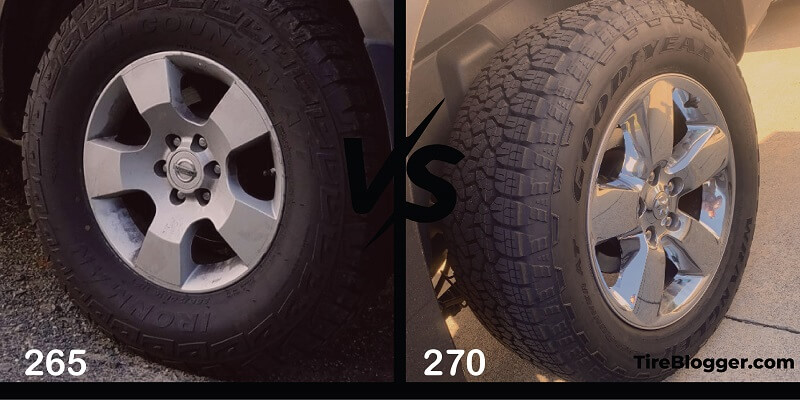265 vs 270 Tires

The 265 tires have a width of 265 millimeters, whereas the 270 has a width of 270 millimeters. That’s five millimeters wider – not much, but enough to make a difference in overall performance.
265 vs 270 Table
Get a quick overview of the differences between 265 and 270 tire sizes with our handy comparison table.
| Tire Size 265 | Tire Size 270 |
|---|---|
| The 265 tire provides a more comfortable ride compared to 270 tire | Consider choosing 270 tires over 265 tires for maximum traction on dry roads |
| The 265 tire is generally less expensive than 270 tire | The 270 tires provide better handling performance than 265 tires |
| The 265 tire offers better traction in snow, rain, and slush than 270 tire | The 270 tires are the better choice for carrying heavier loads than 265 tires |
| Choose 265 tire over 270 tire results in better fuel economy | The 270 tires generally have a more attractive appearance than 265 tires |
| Recommended rim width range for 265 tire is 7.5 to 9.5 inches | Recommended rim width range for 270 tires is 8 to 10 inches |
| The 265 tire size is smaller than 270 tire size by 5 millimeters | 270 tire size is larger than 265 tire size by 5 millimeters |
| The 265 tire size can be used as a replacement for 270 tire size, as they share a similar range of rim widths | The 270 tire size can be replaced with 265 tire size, as they have a similar range of rim widths. |
Ride Comfort
Ride comfort slightly favors 270 tires due to their marginally larger sidewall height, offering better impact absorption on rough terrains.
Conversely, 265 tires might provide a smoother experience on highways and city streets, emphasizing the balance between off-road capability and on-road comfort.

Ground Clearance
Ground clearance is minutely enhanced with 270 tires, benefiting off-road enthusiasts by providing extra protection against rough terrain.
However, the difference is subtle and might not significantly impact everyday driving scenarios.
Gas Mileage
The 265 tires have a slight edge in fuel efficiency due to their smaller contact patch and reduced rotational mass.
The larger width and diameter of 270 tires can increase rolling resistance and weight, potentially detracting from gas mileage.
Aesthetics Look
Aesthetically, 270 tires offer a more aggressive look, appealing to drivers seeking a robust appearance for their vehicle.
On the other hand, 265 tires might blend more seamlessly with the vehicle’s design, contributing positively to aerodynamics.

Handling & Stability
Handling and stability see a nuanced distinction, with 265 tires providing better maneuverability and quicker response on paved roads.
The broader 270 tires might offer increased stability and traction, particularly beneficial in off-road conditions or uneven surfaces.
Noise and Vibration
Noise and vibration characteristics slightly favor 265 tires for a quieter ride on smooth roads, while 270 tires, especially with aggressive treads, might generate more noise but dampen vibrations more effectively due to their increased air volume.
Durability & Wear
Durability and wear patterns may lean towards 265 tires for potentially even wear and longer tread life.
The added weight and impact absorption of 270 tires could lead to more wear on vehicle components, despite their ruggedness.
Adverse Performance
In adverse conditions, the narrower 265 tires could offer better performance in snow and ice by cutting through to the road surface more effectively.
Meanwhile, 270 tires might excel in off-road or muddy conditions, providing superior traction.
Difference Between 265 And 270 Tires?
The difference between 265 and 270 tires lies in their width, with the 270 tire being approximately 5 millimeters (or 0.2 inches) wider than the 265 tire.
This slight variation translates to a 1.9% increase in section width for the 270 tire, affecting aspects like fuel efficiency, handling, and aesthetics, albeit subtly.
How Wide Is A 265 Tire?
The 265 tire is approximately 10.43 inches wide, with the width measured in millimeters, translating to 265 mm.
This width is indicated by the first number in the tire’s size designation, reflecting the tire’s cross-sectional width from sidewall to sidewall.
How Much Wider Is A 270 Tire Than A 265?
The 270 tire is approximately 0.2 inches wider than a 265 tire, with the difference rooted in their millimeter measurements.
This width difference is calculated using the conversion factor of 1 inch equaling 25.4 millimeters, making the 270 tire’s additional 5 millimeters of width translate to about 0.2 inches when compared to the 265 tire.
Our Observation
Given the slight differences between 265 and 270 tires, the choice largely depends on the driver’s priorities. For those prioritizing fuel efficiency, handling, and a quieter ride, 265 tires are the better option.
Conversely, if off-road capability, aesthetics, and stability are more important, 270 tires might be preferred. Ultimately, the decision should align with the vehicle’s intended use and the driver’s personal preferences, as the differences, while subtle, can influence the overall driving experience.

Meet Caitlin McCormack, a Tire Size Expert and Blogger Passionate About Everything Related to Tires. With Years of Experience in the Tire Industry, Caitlin Has Become an Expert in Tire Sizes and Their Impact on Vehicle Performance.
